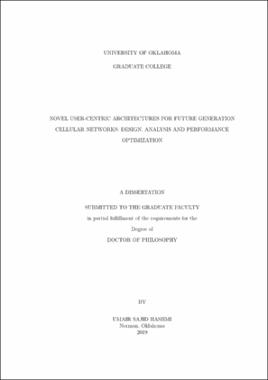| dc.contributor.advisor | Imran, Ali | |
| dc.contributor.author | Hashmi, Umair Sajid | |
| dc.date.accessioned | 2019-08-07T17:24:39Z | |
| dc.date.available | 2019-08-07T17:24:39Z | |
| dc.date.issued | 2019-08 | |
| dc.identifier.uri | https://hdl.handle.net/11244/321126 | |
| dc.description.abstract | Ambitious targets for aggregate throughput, energy efficiency (EE) and ubiquitous user experience are propelling the advent of ultra-dense networks. Inter-cell interference and high energy consumption in an ultra-dense network are the prime hindering factors in pursuit of these goals. To address this challenge, we investigate the idea of transforming network design from being base station-centric to user-centric. To this end, we develop mathematical framework and analyze multiple variants of the user-centric networks, with the help of advanced scientific tools such as stochastic geometry, game theory, optimization theory and deep neural networks. We first present a user-centric radio access network (RAN) design and then propose novel base station association mechanisms by forming virtual dedicated cells around users scheduled for downlink. The design question that arises is what should the ideal size of the dedicated regions around scheduled users be? To answer this question, we follow a stochastic geometry based approach to quantify the area spectral efficiency (ASE) and energy efficiency (EE) of a user-centric Cloud RAN architecture. Observing that the two efficiency metrics have conflicting optimal user-centric cell sizes, we propose a game theoretic self-organizing network (GT-SON) framework that can orchestrate the network between ASE and EE focused operational modes in real-time in response to changes in network conditions and the operator's revenue model, to achieve a Pareto optimal solution. The designed model is shown to outperform base-station centric design in terms of both ASE and EE in dense deployment scenarios. Taking this user-centric approach as a baseline, we improve the ASE and EE performance by introducing flexibility in the dimensions of the user-centric regions as a function of data requirement for each device. So instead of optimizing the network-wide ASE or EE, each user device competes for a user-centric region based on its data requirements. This competition is modeled via an evolutionary game and a Vickrey-Clarke-Groves auction. The data requirement based flexibility in the user-centric RAN architecture not only improves the ASE and EE, but also reduces the scheduling wait time per user.
Offloading dense user hotspots to low range mmWave cells promises to meet the enhance mobile broadband requirement of 5G and beyond. To investigate how the three key enablers; i.e. user-centric virtual cell design, ultra-dense deployments and mmWave communication; are integrated in a multi-tier Stienen geometry based user-centric architecture. Taking into account the characteristics of mmWave propagation channel such as blockage and fading, we develop a statistical framework for deriving the coverage probability of an arbitrary user equipment scheduled within the proposed architecture. A key advantage observed through this architecture is significant reduction in the scheduling latency as compared to the baseline user-centric model. Furthermore, the interplay between certain system design parameters was found to orchestrate the ASE-EE tradeoff within the proposed network design. We extend this work by framing a stochastic optimization problem over the design parameters for a Pareto optimal ASE-EE tradeoff with random placements of mobile users, macro base stations and mmWave cells within the network. To solve this optimization problem, we follow a deep learning approach to estimate optimal design parameters in real-time complexity. Our results show that if the deep learning model is trained with sufficient data and tuned appropriately, it yields near-optimal performance while eliminating the issue of long processing times needed for system-wide optimization.
The contributions of this dissertation have the potential to cause a paradigm shift from the reactive cell-centric network design to an agile user-centric design that enables real-time optimization capabilities, ubiquitous user experience, higher system capacity and improved network-wide energy efficiency. | en_US |
| dc.language | en_US | en_US |
| dc.rights | Attribution-NonCommercial-ShareAlike 4.0 International | * |
| dc.rights.uri | https://creativecommons.org/licenses/by-nc-sa/4.0/ | * |
| dc.subject | Artificial Intelligence. | en_US |
| dc.subject | Telecommunications | en_US |
| dc.subject | Electrical and Computer Engineering | en_US |
| dc.title | NOVEL USER-CENTRIC ARCHITECTURES FOR FUTURE GENERATION CELLULAR NETWORKS: DESIGN, ANALYSIS AND PERFORMANCE OPTIMIZATION | en_US |
| dc.contributor.committeeMember | Imran, Ali | |
| dc.contributor.committeeMember | Runolfsson, Thordur | |
| dc.contributor.committeeMember | Refai, Hazem | |
| dc.contributor.committeeMember | Chan, Kam Wai Clifford | |
| dc.contributor.committeeMember | Adams, Curt | |
| dc.date.manuscript | 2019-08 | |
| dc.thesis.degree | Ph.D. | en_US |
| ou.group | Gallogly College of Engineering::School of Electrical and Computer Engineering | en_US |
| shareok.orcid | 0000-0001-8704-7132 | en_US |
| shareok.nativefileaccess | restricted | en_US |

